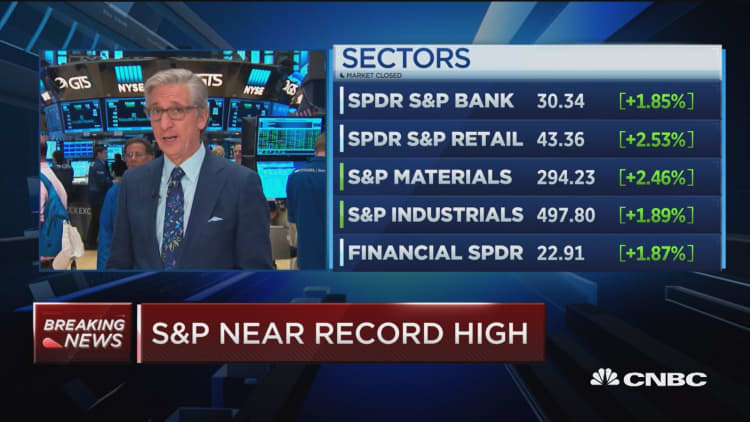
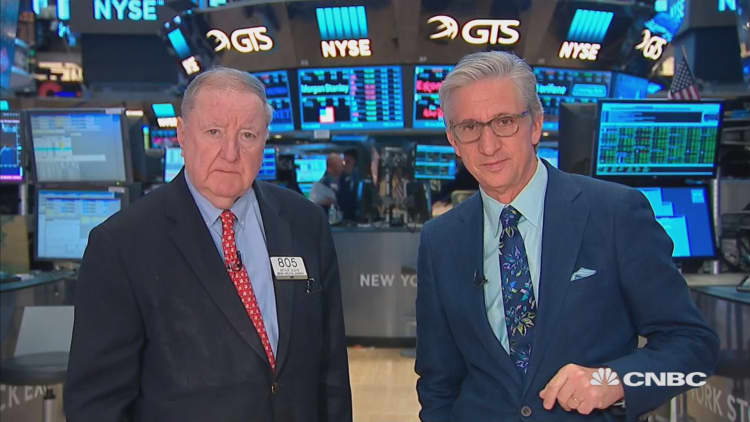
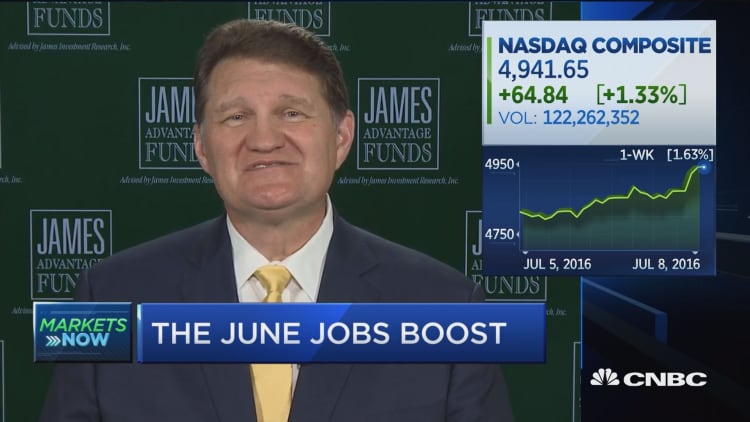
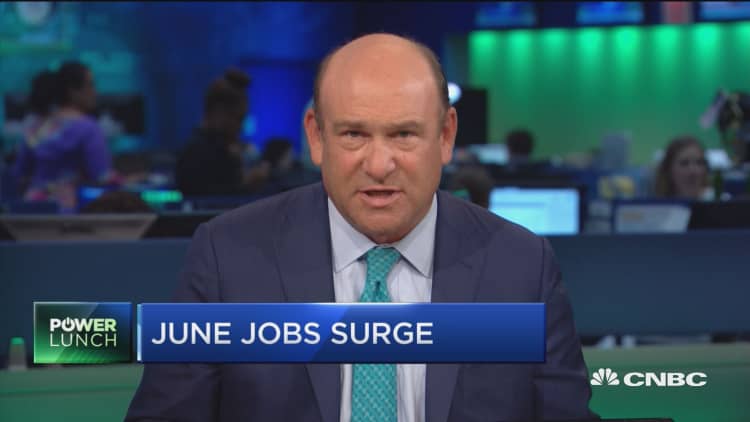
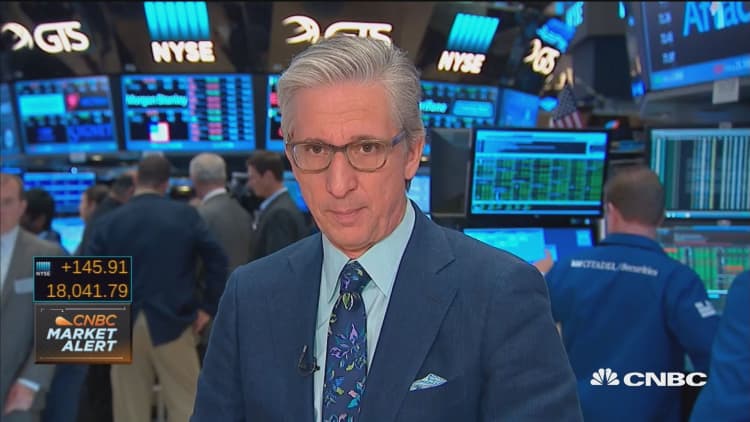
U.S. stocks closed more than 1 percent higher Friday, more than recovering their post-Brexit losses, after a surprisingly large beat on the June jobs report headline figure.
"What's got us here right now is the pickup in the employment data is signs of hope we're in economic recovery," said Lance Roberts, chief investment strategist at Clarity Financial. "The question becomes, is this a one-month anomaly, or is this the start of a bounce in economic recovery? But stocks are responding in this vein."
The major U.S. indexes closed off session highs. The S&P 500 ended within 1 point of its record close of 2,130.82 hit last May after briefly topping that level in intraday trade. The S&P's all-time intraday high is 2134.72, touched May 20, 2015.
Materials closed nearly 2.5 percent higher to lead all 10 S&P sectors higher. Industrials and financials were the second- and third-best performers. Traders also attributed some of Friday's gains to short covering.
"I'm still a believer we're going to stay in a range. I just don't see what the catalyst is to keep us rallying significantly," said JJ Kinahan, chief strategist at TD Ameritrade.
The Dow Jones industrial average closed about 250 points higher, roughly 1.1 percent below its all-time intraday high of 18,351.36 touched May 19, 2015. The Dow's record close is 18,312.39. Goldman Sachs, Home Depot and Boeing contributed the most to gains as all constituents rose Friday.
"I think the market's focused on external events," said Bernie Williams, chief investment officer, USAA Investment Solutions. The "U.S. is still the safe harbor in the world."
The Dow transports had their best day since mid-April as the index outperformed with gains of 2.55 percent, while the Russell 2000 climbed 2.4 percent in its best day since late March.
"There was a great deal of worry after such weak jobs growth in May and with June's jobs number much, much stronger than expected that provides relief," said Kate Warne, investment strategist at Edward Jones. "At the same time, ... it wasn't so strong to suggest the Fed has to hike rates."
The U.S. dollar index was little changed after swinging higher and lower in the first reaction to the jobs data. The euro was near $1.105 and the yen near 100.5 yen versus the greenback.
The initial reaction to the report called for strength in the dollar index, Andres Jaime, global FX and rates strategist at Barclays, said in an email. "But I think people realized that one number (does) not really change the odds for hikes this year given that major central banks are poised to ease and uncertainty is at all-time highs in Europe."
Longer-end Treasury yields held just above recently touched record lows. The 10-year yield was around 1.36 percent and the 30-year yield was near 2.10 percent. The was higher near 0.61 percent.
The CBOE Volatility Index (VIX), widely considered the best gauge of fear in the market, traded near 13.2, a one-month low.
"The bonds and the VIX are telling you two different things," Kinahan said. "The VIX seems to be (saying there's) nothing to be worried about."
One-month performance
The nonfarm payrolls report showed the United States created 287,000 jobs last month, versus 175,000 expected by economists surveyed by Reuters. The unemployment rate edged higher to 4.9 percent, versus the 4.8 percent estimate.
"Certainly the jobs created number was big ... but the rest of the report really wasn't as good," said Chris Gaffney, president, EverBank World Markets.
"There are so many uncertainties that on the currency side of the ledger we don't see the possibility of an interest rate hike (by the Fed) in 2016," he said, citing concerns around Brexit and the U.S. presidential elections.
May's payroll count was revised down to only an 11,000 increase from the previously reported 38,000, Reuters said. However, most analysts emphasized the three-month trend showed a steady pace of job creation.
Average hourly wages rose 0.1 percent in June for a year-over-year increase of 2.6 percent.
"Consumer spending is going to continue to move forward," said Steve Rick, chief economist at CUNA Mutual.
With Friday's gains, the S&P and Dow rose more than 1 percent for their second-straight week of gains. The Nasdaq composite also posted its second-straight week of gains with a rise of 1.9 percent for the week.
The Dow and S&P were within 0.2 percent of their 52-week intraday highs, while the Nasdaq was about 5.3 percent below.
"I think investors should be more excited about stocks at record highs than they are," Warne said. "The skepticism that investors have is a good sign for stocks' ability to move higher, but no one's excited about the market. Everybody's focused elsewhere."
European stocks were about 1.5 percent lower or more for the week despite Friday's gains. The German DAX was up more than 2 percent and the STOXX Europe 600 Banks index more than 3.5 percent higher.
Asian stocks ended lower, with the Nikkei 225 1.1 percent lower and the Shanghai composite off nearly 1 percent.
"The S&P futures are rallying strongly this morning, boosted by the jobs report," Katie Stockton, chief technical strategist at BTIG said in a note.
"Yesterday saw intraday oversold conditions return, contributing to today's bullish bias," she said. "However, resistance is strong for the SPX in the 2100-2135 area, and momentum does not appear strong enough to generate a decisive breakout. We expect short-term overbought conditions to give way to a pullback next week."
Major U.S. Indexes
The Dow Jones industrial average closed up 250.86 points, or 1.40 percent, at 18,146.74, with Caterpillar gaining 3 percent to lead all constituents higher.
The index gained 1.1 percent for the week with Intel the top performer and DuPont the worst.
The closed up 32.00 points, or 1.53 percent, at 2,129.90, with materials leading all 10 sectors higher.
The S&P rose nearly 1.3 percent for the week with consumer discretionary the top performer and telecommunications and energy the only decliners on the week.
The Nasdaq composite closed up 79.95 points, or 1.64 percent, at 4,956.76.
The Nasdaq composite gained 1.9 percent for the week. Apple gained 0.8 percent for the week. The iShares Nasdaq Biotechnology ETF (IBB) rose nearly 3.2 percent for the week.
About nine stocks advanced for every decliner on the New York Stock Exchange, with an exchange volume of 919 million and a composite volume of 3.5 billion in the close.
High-frequency trading accounted for 49 percent of July's daily trading volume of about 7.00 billion shares, according to TABB Group. During the peak levels of high-frequency trading in 2009, about 61 percent of 9.8 billion of average daily shares traded were executed by high-frequency traders.
U.S. crude oil futures for August delivery settled up 27 cents, or 0.6 percent, at $45.41 a barrel. Oil lost 7.3 percent for the week, its worst since February 5.
Gold futures for August delivery settled $3.70 lower at $1,358.40 an ounce.



